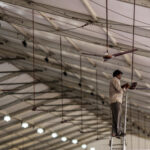As blame for California’s wildfires rises over Sacramento like smoke from last year’s blazes, the state is being forced to confront the possibility that it’ll happen again in 2018.
California’s drought is worsening, and blazes have charred more acres in the first six months of this year than they did in the same period in 2017, a year that ultimately set records for destruction and deaths. The state is covered with dried-out brush and the skeletal branches of 129 million trees killed by a bark-beetle infestation. Hundreds of miles of electric transmission lines run through the dead forests and crisscross hills crowned with golden, dried grass.
More than 85 percent of California’s natural landscape is abnormally dry, up from 22 percent at the start of the water year in September, according to data through July 10 from the U.S. Drought Monitor in Lincoln, Nebraska. Drought now covers over 44 percent of the state. That’s not good news for Californians still recovering from one of the worst-ever years for wildfires.
“It’s mirroring last year,” Scott McLean, deputy chief of the California Department of Forestry and Fire Protection, said in a telephone interview. “Grass and brush are just tinder, they are like a fuse for these wildfires.”
Scorched Earth
California fires consumed 12,000 more acres through July 8 than in the year-earlier period, Cal Fire data show. The actual total was 141,000 acres beyond that because some fires still haven’t been tallied in the state’s database, McLean said.
In 2017, rains that ended a six-year drought coaxed to life a mass of vegetation which ultimately became tinder for the blazes. Forty-six people died, 1.3 million acres were seared and billions of dollars in homes and businesses were consumed. California spent $759 million fighting wildfires in the year ended June 30, McLean said.
Last year’s fires consumed wine grapes, hurt avocados and some of the state’s extensive citrus groves. If flames were to erupt across California’s Central Valley, a variety of crops would be endangered. California farms and ranches produced more than $47 billion in agricultural products in 2015, according to the state’s Department of Food and Agriculture.
The blazes quickly put California’s electric utilities into the crosshairs, with PG&E Corp. and Edison International’s Southern California Edison facing potentially massive liabilities if their equipment ignited the wildfires. State investigators have so far linked PG&E equipment to 16 of a swarm of fires that swept through Northern California wine country in October, causing about $10 billion in insured losses. Forty-four of the deaths occurred in the wine country fires.
Taking Steps
The utilities are taking steps to prevent another disaster. After last year, California regulators ordered them to clear branches and trees farther away from overhead power lines. State lawmakers are also considering a package of bills that would improve disaster planning, add emergency-response resources and require utility safety plans.
PG&E and Edison say they have developed procedures to cut power in areas where extreme fire conditions are occurring, a practice that has been used by Sempra Energy’s San Diego Gas & Electric. PG&E and Edison said they are taking other measures to reduce fire risk such as expanding their network of weather monitoring stations, increasing patrols of power lines and hardening their power poles and lines.
“We are looking at fire season as a year-round event now,” said Phil Herrington, senior vice president of transmission and distribution at Southern California Edison. “The new normal is how we refer to it.”
San Diego Gas & Electric said its “aircrane helitanker” – which can drop almost 3,000 gallons (10,000 liters) of water — has responded to more fires and dropped more water so far this year than it did in all of 2017.
Uncertain Forecast
As quickly as the fire season has raged throughout California in the first part of the year, there is no way to forecast what the rest of 2018 will be like, McLean said. A lot will depend on what people do and how the weather develops. In the end, it could come down to a dry hour over the wrong patch of grass.
The fire threat has spread across the U.S. West, with states including Washington and Oregon experiencing abnormally dry conditions, according to a report by the National Interagency Fire Center.
Humans caused about 84 percent of all U.S. wildfires in the two decades through 2012 and have tripled the length of fire seasons, according to 2017 paper published in the Proceedings of the National Academy of Sciences by Jennifer Balch, the director of the Earth Lab at the University of Colorado in Boulder. This is a big reason fire season has expanded, said Janice Coen, project scientist at the National Center for Atmospheric Research in Boulder, Colorado.
“Humans are moving into areas that are ignitable,” Coen said. Blazes now occur “due to humans spreading into those places igniting fires that wouldn’t necessarily be created by storms.”
Was this article valuable?
Here are more articles you may enjoy.

 Waymo to Update Software Across Fleet After Major Power Failure
Waymo to Update Software Across Fleet After Major Power Failure  Insurance AI Demo Day Calendar Announced
Insurance AI Demo Day Calendar Announced  The Best Climate Adaptation Methods Are Surprisingly Simple
The Best Climate Adaptation Methods Are Surprisingly Simple  Tesla Drivers Are Buying Escape Tools and Cars to Avoid Getting Trapped Inside
Tesla Drivers Are Buying Escape Tools and Cars to Avoid Getting Trapped Inside 